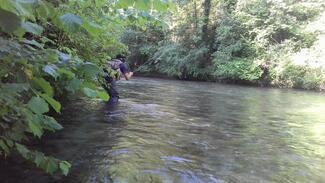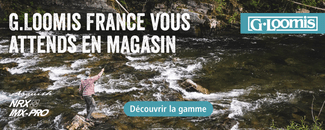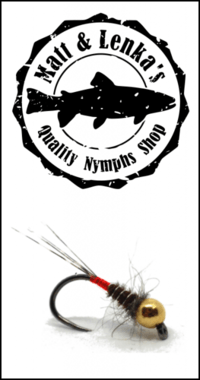Fishing for trout in white waters is usually upstream, in sections of rivers with a wide variety of spots. It requires a good positioning in order to optimise the presentation and the drift. Forgot by many, positioning is one of the most important things in fly fishing. Keep in mind that the perfect fly choice and a fine tippet, when they can’t offer a dead drift, are useless. Positioning and approach are necessary to obtain the right drift. White waters are an ideal training field to learn. Indeed, encountered situations are always very different and it’s a must to improve. Acquiring automatisms will allow to be more efficient and improve in a wide range of different situations.
Comprehensive process :
The chosen spot before casting its line will need to present those qualities :
- Allow the fisherman to stay invisible for the trout.
- Provide good casting and drift conditions (comfortable distance, not too covered by vegetation).
- Allow a good vision on the fly or indicator during the drift.
Find such a spot, fulfilling all those qualities, is almost impossible. But even if it has just one or two of them, it will allow catching fish. The fly fisherman will always have to counterbalance technically the handicaps that fishing condition will throw at him. In those moments, skills in the different casting types and ability to adapt will bring him at the top of his game. Here are the logical following events he will be facing:
Reading the water and approach
Reach a spot always starts with an observation step, in static position (human brain doesn’t think properly while walking). The currents carrying most of the food are made by the terrain variety, which make them unique. For example, a marl that is getting tinier when it’s coming close to the bank will make the current faster. While a big rock in the middle will slow it down and divide it in two downstream. All those hydraulic and environmental factors tell you where the trout lies, and where is the target to focus while casting. Without acknowledging those factors and without capability of adaptation and reflexion, it is impossible to fish properly. Once the objective is set, the approach of the spot, or the fish if sight fishing begins. It obviously must be stealth, not overhanging on the water, from down to upstream, in the same way the fish would be positioned. You must stop wherever you decide you will start casting. The good casting spot takes heed of :
Distance and angle
Objectives :
The fishing distance is the distance between the fisherman ready to cast and the very valued fish, if visible, or the current where it might be if not. Too short distance between the fisherman
and the fish will see the fish spook. But too long distance will make the cast and the drift much harder. The further you fish, the worse is the drift. Once again, it is a matter of balance between too short and too far.
The angle is the imaginary angle formed by the line “fisherman fish” and the tangent to the trout facing the current. More the fisherman is in the axis with the trout, more this angle gets close to 0°. On the other hand, the more he approaches the trout from the side, the more the angle will get close to 90°. We call three quarter upstream the intermediate position between the two extreme positions.
Being well-placed means pick a spot without influence either on fish behaviour or on the drift. This is the main goal. The perfect placement choice is often a matter of few centimetres. A lack of small distance considerably influences the follow events.
Methods :
The ideal distance and angle to cast either to a fish or blind fish a nice spot are completely dependant to the environment of the spot and fishing condition.
First case : obstacles are on the way. When physical barriers are on the way (rocks, vegetation) the hide you from the fish’s vision and you can shorter the fishing distance. It is quite often that a trout will rise above a big rock for example, but it is not always true. You would have to position in the same line as the obstacle and the trout not to be seen.

Second case: no obstacles on the way. In most situations, they won’t be any barriers between you and the trout. In this case, you must define the ideal distance and angle according to light intensity, depth and current speed. You can also include watercolour.
Generally speaking, with a high ratio between current speed and depth is and a low light intensity will allow you to decrease the fishing distance and pick the angle you prefer. For nymphing, the ideal is three-quarter upstream, for dry fly it’s the angle that allows you the perfect drift. The other way round, with low flow, high light intensity and gin-clear water, you want to increase the distance and reduce the angle with the trout position.
All the fishing situations are different, you might want to trust your gut feeling and experience. According to the fish, minimal distance to not past will be shown day after day. After a while, it will become an automatism, mostly if you get out often on the same waters. The trout from one river won’t have the same degree of tolerance from another.
When you spot a fish, observation of his behaviour will tell you soon enough if you went too far. End of rises, fins moving fast means the fish has been disturbed and is wary.
The fly visibility
Objectives :
Be able to see well his fly in those agitated waters is an important fact on your success. The goal is to properly distinguish it as soon as it hits the surface and for the whole duration of the
drift to be able to detect the occurrence of a rise but also to make sure the drift is all right and it’s not dragging.
Methods:
If the stream’s configuration (as for the spots as the riparian vegetation) and the level of confidence of the fish make the progress possible in the water on both banks, you will select the one offering the best visibility. Polaroid glasses are a must, but they can’t allow you to see everything. I’d suggest you pick the bank with the best visibility, if only the previous standards are fulfilled (stealth + good drift conditions).
As a matter of fact, during low flow and high luminosity in summer, using the shaded bank to progress is the ideal method. Fishing with a very small angle, from behind fish positioned on the same edge as you are forcing you to fish with backlight. However, it is better to have trouble distinguishing its fly than cast in empty spots isn’t?
Sometimes, even in some extremely bad visibility situations, if the number of favourable spots is high enough, you can skip the worse. Generally, keep in mind the flies that work in white waters have an excellent visibility and a high-floating capacity.
Adopt a placement according to the fishing style: sight or blind fishing.
The possibility to spot a feeding fish or not influences the placement and modifies your strategy. Indeed, sight fishing (with nymphs or dries) contributes to adopting a different placement that you would have while blind fishing.
For sight fishing:
The location where the fish is feeding will determine where the fisherman will have to be. We can qualify it as “personalised”. Our placement will not take care of the other currents where other fish could be anymore. The objective is to position in the best way to cast to that fish you just spotted. But be careful, in high fish density rivers, too quick progression is the best way to spook all the fish around, including the one you’ve been targeting. A few blind casts beforehand can sometimes reveal themselves handy.
For blind fishing :
When you prospect a spot without any salmonid visible, the placement is made to be able to exploit progressively the whole section. This position must allow a perfect scan of all the currents available with as much stealth as possible. All that with the guarantee of a good fishing comfort. So progress is made step by step, always casting the fly as close to you as possible in order to catch the closest fish first and avoid spooking them with the line. The priority is given to the way offering the best condition to fish “food carrying currents” as illustrated on the picture :
More articles on withe waters soon !


